
He sat across my desk, in my office. He looked me in the eye and said,’Did you know that you can tell the colour of a woman’s nipples by the colour of her lips?’
Another used his 120kg of bulk to trap me against a wall at a crowded work function, leering at me.
A co-worker clumsily groped me in a public space at a conference, again and again. I left
A professional colleague handed me a sheaf of his writing, watching me read his poorly written soft porn as we sat in a public cafe.
As I attempted to call our meeting to an end, he stood in my office so as to block my exit from behind my desk. My office door was open at all times.
These are some stories from my working life as a practising lawyer and as a legal academic over 30 years. One of these stories happened this year. I know that other women have it worse.
These experiences came to mind as I read allegations this week, made by three young women lawyers about their experiences working for a senior lawyer. The man allegedly sent the women to fetch his Viagra from the pharmacy, hired based on physical attractiveness, had pornography visible in his office, made sexually explicit comments, and showed a drawing of his penis.
While reading the stories of the three women, I reflected back on my feelings in similar circumstances. At first I thought it was deep shame that I felt – even after all these years. But I suspect that it is in fact fear. I was afraid of the potential of force – of violence – that each of these situations represented. I can only imagine the fear and confusion experienced by the young women who shared their stories.
Remember – this all happened in professional contexts.
I’ve written before about sexism and harassment in the legal profession (and here, and here). The stats aren’t getting better. Those in the legal profession know it is unlawful to sexually harass. Such behaviour breaches discrimination law, and workplace law. For good measure, it also breaches professional ethics. But it continues.
In some quarters, such behaviour is an open secret. This makes us all, the entire profession, complicit. The young women who have made the most recent allegations – and others like them – have thus experienced powerlessness, and maybe those same feelings of fear that I have had, in the face of our complacency.
There are three actions we in the profession must take. Especially senior members of the profession, and especially men.
- Call out sexual harassment. Expose the open secret by telling the harasser to stop. It’s not banter, it’s not a joke. Tell them straight just to stop. Team up with others and together tell the harasser that it is unacceptable behaviour in your workplace. Use the power of our professional culture for good, and turn things around.
- Support the person on the receiving end of the harassment. Ensure that they are supported by others. Shut down gossip. And, do not be that gossip. Hard, I know, in a gossipy profession. But gossip adds to the complicity.
- I think we need to look to the overall culture of the profession, and our tacit acceptance of such behaviour – and to look for action outside discipline as a first call. However, if they don’t stop, report the behaviour to your professional body. And call the professional body to account if it fails to act.
If such actions are reported to you, it’s not enough just to support the complainant. You must deal with the alleged harasser too. In my own case, I have been personally well supported by men – but in some cases the man about whom I have complained has not been censured, and his bad behaviour continues.
It is therefore our responsibility as employers, and as colleagues, to alert the man to his poor behaviour, to let him know that it is unacceptable, and to sanction it. Otherwise, we know that it will continue. And we will see yet another generation of lawyers suffer the same fate.
I can’t believe I’m writing this. In 2017. About lawyers. But here it goes.
Please. Stop sexual harassment. Do not continue to be a bystander.


 Yesterday the Australian Minister for Education, Simon Birmingham,
Yesterday the Australian Minister for Education, Simon Birmingham, 
 My
My 